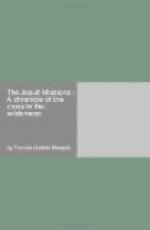The Jesuits, however, were anxious to labour among the Iroquois, and at their request the governor adopted a temporizing policy. Before giving a final reply it was deemed wise to send an ambassador to the Five Nations to spy out the land and confirm the peace. This dangerous task was assigned to the veteran missionary Father Simon Le Moyne. In the spring of 1654 Le Moyne visited the Onondagas. His diplomacy and eloquence succeeded with them, but the Mohawks still continued their raids on the settlements. Nevertheless in 1655 the Mohawks again sent messengers to Quebec professing friendship. Le Moyne once more took up the task of diplomat and journeyed to the Mohawk country in the hope of making a binding treaty with the fiercest and most inveterate foes of New France. In this same year a large deputation of Onondagas arrived at Quebec. They wished the French to take immediate action and establish a mission and colony in their midst. Once more their sincerity seemed doubtful; and Fathers Chaumonot and Dablon were dispatched to Onondaga to ascertain the temper and disposition of the Indians there. After spending the winter of 1655-56 in the country, where they had conferences in the great council-house of the Five Nations with representatives of all the tribes, the two fathers believed that the time was ripe for a mission. A colony, too, in their judgment, would be advisable; it would serve at once as a centre of civilization for the Iroquois and a barrier against the Dutch and English of New York, who hitherto had monopolized the trade of the Iroquois. In the spring of 1656 Dablon returned to Quebec to advise the governor to accept the terms of the Onondagas, while Chaumonot remained at Onondaga to watch over his new flock both as missionary and as political agent.
An expedition, the entire expense of which fell on the Jesuits, was at once fitted out. The town major of Quebec, Zachary du Puys, took military command of the party, which consisted of ten soldiers, thirty or forty white labourers, four Jesuit fathers—Menard, Le Mercier, Dablon, and Fremin—two lay brothers, and a number of Hurons, Senecas, and Onondagas. On the 17th of May the colonists left Quebec in two large boats and twelve canoes. They began their journey with forebodings as to their fate, for the Mohawks were once more haunting the St Lawrence. Scarcely had Du Puys and his men passed out of sight of Quebec when they were attacked. The Mohawks, however, pretended that they had supposed the party to be Hurons, expressed regret for the attack, and allowed the expedition to proceed. At Montreal the boats were discarded in favour of canoes for the difficult navigation of the upper St Lawrence. Save for Le Moyne, Chaumonot, and Dablon, these colonists were the first whites to ascend the St Lawrence between Montreal and Lake Ontario; the first to toil up against the current of those swift waters and to portage past the turbulent rapids; the first to view the varied




